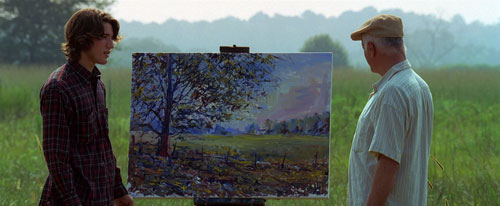Timing is Everything: Easy Virtue (2009)

Directed by Stephan Elliott
Screenplay by Elliott and Sheridan Jobbins
Reviewed by Cindi Di Marzo
This year, admirers of Noel Coward’s sophisticated comedies of manners have reason to rejoice. Opening earlier in 2009 on Broadway, a new production of Coward’s three-act farce, Blithe Spirit, features a deliciously loopy Angela Lansbury as Madame Arcadi, a spiritualist who unwittingly brings forth the ghost of a novelist’s first wife. Wife number one’s appearance shatters wife number two, who winds up a ghost herself by the end of the play. For those who may not make it to Broadway, Coward (1899-1914), whose talents ranged far as playwright, composer, director, actor and singer, can be celebrated in movie theaters. Filmed by Alfred Hitchcock in 1928 as a silent dark comedy, Coward’s Easy Virtue has achieved new life in director/screenwriter Stephan Elliott’s (The Adventures of Priscilla Queen of the Desert) mostly successful adaptation. The film opened in July to theaters in the U.S.
Coward wrote Easy Virtue in 1924, early in his career, when he was 25-years-old. First staged in 1941, Blithe Spirit is a mature work. Coward punctuated his plays with some of the most wicked and witty dialogue penned for the stage. In Blithe Spirit, his characters’ repartee is fast and furious, with little time left for a breath between barbs and instances of exaggerated physical comedy. David Lean directed a well-received film version of Blithe Spirit (1945), starring Rex Harrison as the husband and Margaret Rutherford as the medium.
The dialogue in Coward’s earlier works is not as frenetic, and this is true for Easy Virtue. The storyline can be laid out fairly simply: While traveling abroad, a young Englishman, John Whittaker (Ben Barnes) is captivated by a daring, ravishingly beautiful American, Larita Huntington (portrayed with mixed results by Jessica Biel). Impulsively, he marries Larita, to the horror of his iron-willed, tradition-bound mother and his two sisters, Marion (Katherine Parkinson) and Hilda (Kimberley Nixon). Larita has many strikes against her as an American racecar driver who doesn’t ride horses; is morally against hunting; sports a movie star-quality platinum blonde hair-do; appears dazzling in an evening gown; and is on her second marriage. These qualities enchant her new husband, but at heart John Whittaker is an English schoolboy. Raised on a country estate and boarding-school educated, he aspires to nothing more than a shallow, traditional way of life that repels his thoroughly modern bride. By turns, Barnes is suitably suave and playful. Certainly, Biel looks the part of the daring American femme fatale. And she is marvelous dancing the Can-Can. Though her character falls flat at times, from the start viewers will be on her side and continue to route for her against her vicious in-laws.
John and Larita’s “brief” sojourn to Surrey to meet the family runs well beyond Larita’s expectation and tolerance level. She is perplexed by her in-laws exceeding eccentricities; old-maid Marion is a bitter pill and Hilda’s obsession with news reports of the recently departed is creepy. Kristen Scott Thomas as mother-in-law does Coward proud. Trying to keep the failing estate solvent may have withered Mrs. Whittaker’s beauty, but her stubborn resolve to remain in control of her property, family and cherished way of life would daunt the fiercest warrior. A manipulative, scathing critic of her son’s bride, Mrs. Whittaker loses no opportunity to puncture, with her daughters’ assistance, Larita’s self-esteem, even stooping to surrounding the allergy-prone Larita with vases of flowers at every opportunity.
For her part, Larita does everything wrong, speaks her mind and bonds with John’s father, played to perfection by Colin Firth. A dark horse whose place is the family baffles Larita until she learns of his past, Mr. Whittaker has become superfluous to his family, an unreliable and, occasionally, threatening figure in their quiet country life of fox hunts, tennis games, cricket matches and gala social events. But Larita finds more allies than the mysterious Mr. Wittaker. Choosing to call the cook (Joanna Bacon) by her name (a truly American gesture), Larita also bonds with Furber, the butler (Kris Marshall), whose subversive aid helps Larita through some sticky situations (among them, a rather unfortunate incidence involving a beloved family pet).
Coward purists might be troubled by a major plot change in which, rather than a divorcé, Elliott conceives of Larita as a widow convicted (but acquitted) of her husband’s murder. Yet this detail helps make Larita’s character and attachment to Mr. Whittaker more convincing. For the English upper classes during the early twentieth century, a divorce was, indeed, scandalous. Today, the notion loses much of its weight. Larita might seem to be a typical, Jazz-age adventurer, seeking thrills by traveling, racing cars and snagging a rich husband, but the loss of a husband through serious illness and an economically sketchy history has resulted in her devil-may-care attitude. Mr. Whittaker is cast adrift after seeing his comrades gunned down, while Larita loses something precious and knows it. Their ability to leave it all behind comes, in his case, from being lost; in hers, from a desire to experience life again.
Some may consider Elliott an odd match for Coward. The playwright excelled with perceptive skewering of upperclass English values and lifestyles. Elliott remains faithful to Coward’s intentions and admirably pulls off his own diversions; his risks pay off. Elliott restores Easy Virtue to the light comedy that Coward meant it to be, a romp through the hilariously superficial social lives of upper-class English clans that also satisfies with substance. (In his autobiography, Coward did not acknowledge Hitchcock’s film.)
Produced by Elliott and Marius de Vries, the soundtrack is a mix of old and new, as well. It features several songs composed by Coward (Mad Dogs and Englishmen, for example), popular hits from the 1920s and ’30s by Cole Porter and other popular composers (Mad About the Boy, Makin’ Whoopee, etc.), and contemporary songs (Car Wash, When the Going Gets Tough, the Tough Get Going).
At one point in her tangle with the in-laws, Larita retorts to one of John’s sisters, “Timing is everything.” This line sums up Coward’s artistic manifesto. Calculated for supreme effect, each line and action in Coward’s best works evinces an exquisite sense of timing. Given Coward’s success, it might be unfair to expect the same from Elliott. The real marvel is that, new to Coward’s work, Elliott created a lively, diverting and, ultimately, moving portrayal of upperclass England between the wars.













